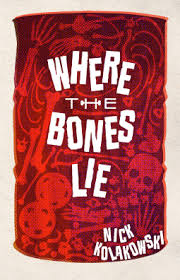A Specific Number of Questions with Nick Kolakowski

Nick Kolakowski is a writer.
I mean, we’re all writers, but he’s a writer’s writer. He puts out books with a workman like effort bouncing from horror to noir to thrillers and even some sci-fi.
But his latest, a Where the Bones Lie, is a slick, twisty thriller. Here’s the synopsis:
For Dash Fuller, Hollywood’s underbelly is home. He’s spent years making the film industry’s worst secrets disappear, and it’s left him a cynical burnout with a taste for bourbon and self-loathing.
But when a young woman comes to him with a peculiar quest, Dash sees a chance at redemption. Madeline Ironwood is the daughter of Ken Ironwood, a notorious smuggler and murderer who disappeared 20 years ago. Ken’s skeleton has just been discovered in a barrel at the bottom of a dried-up lake, and Madeline wants to know who killed him.
Dash agrees to help, and as this desperate daughter and jaded cynic claw their way through a world of sun-bleached secrets, crooked cops, and Hollywood thugs, they soon uncover a conspiracy involving some of LA’s most powerful people.
Get ready for a fast-paced, darkly funny thriller with a twist you won’t see coming.
I was lucky enough to chat with Nick about the book. Check out the interview here:
You work full time, you have a baby at home. How do you find the time to write? What is your routine?
I was fortunate in that I finished writing WHERE THE BONES LIE in September 2023, a good while before the baby was born. During those halcyon-in-retrospect days, I had a full 60-90 minutes per day (!) to write fiction in relative peace. After the baby—that’s all out the proverbial window. Now I write during whatever spare moments I can snatch: 30 minutes here, 15 minutes there. I suspect most parents have a similar ‘system’ in place.
The good thing is that my productivity hasn’t been completely demolished. I went through the editing process with Datura while bouncing a baby around, and I’ve managed to churn out a handful of short stories and one commissioned film treatment over the past year. But the routine is, for better or worse, a complete lack of routine.
Give us the elevator pitch for WHERE THE BONES LIE. What was the genesis of this story in your mind?
WHERE THE BONES LIE is about a disgraced Hollywood fixer named Dash Fuller who helps a young woman, Madeline Ironwood, find out who murdered her father, a famous smuggler whose bones are discovered in a rusted-out barrel in rural California. Along the way, they have to deal with everyone from studio executives to shady vineyard owners to the usual collection of thugs, killers, and other bottom-feeders.
The plot’s origins go back a few years, when we started seeing news reports about lakes drying up in Nevada and California due to climate change. Cops began finding the bones of various criminals who’d been tossed in those waters many years ago. I thought that was a cool kernel for a story of some kind. At roughly the same time, I was tinkering with writing a “classic” California noir in the vein of Chandler, albeit updated to the modern world. From there, I threw in my personal experiences from working out in L.A. for a number of years, interviewing celebrities and generally stalking around, and I had the book’s foundations set.
Nerdy Process talk time. Do you outline? Character bios? How do you go about your writing process?
For the longest time, I was a pure “pantser,” following my impulses on the page and then rewriting later for clarity and consistency. This is the first book I rigorously outlined, because when you’re writing a detective mystery with the usual freight of red herrings and twists and suspects, there’s an added need to keep all the details correct from the outset—if only to keep your stress levels lower during the rewriting stage. Even then, some late bursts of inspiration led me to aggressively shift the book’s ending from what I’d originally outlined.
I don’t do character bios, because my characters often evolve on me as I write, which makes the bios quickly obsolete. Plus, I find one of the joys of writing is discovering the nuances of a character as I write, as well as shifting them in relation to other characters as they interact. The best moments are when characters take over in your head and start dictating their own behavior and fates.
You are an East Coast guy. How did you go about researching and getting in the head of a Hollywood fixer?
I spent years as an entertainment journalist, interviewing celebrities and directors and folks like that. As a part of that business, I ran into a lot of PR folks and fixer types who help keep the wheels of the entertainment industrial complex churning right along. Some of Dash’s personality and stories are adapted from those folks; some is based on things I heard secondhand; and some is just pure fiction, because Dash becomes more of a detective as the book goes on.
What was the most difficult part of writing this book? And how did you solve the problem?
The book’s original ending was completely different, and it really didn’t work at all. It didn’t work to the point where I actually had to walk away from the thing for two or three months in despair. Fortunately, my brain gifted me the answer at a random moment, which is why the book now has a (in my opinion) very cool, 90s-film-style twist. I love the subconscious—I think it was Cormac McCarthy who called it the invisible butler or something along those lines, working on problems even if you’re not aware of it. I’m not sure if my subconscious has gotten me into more trouble or gotten me out of it.
Thanks, Nick! Everyone, go check out the book!